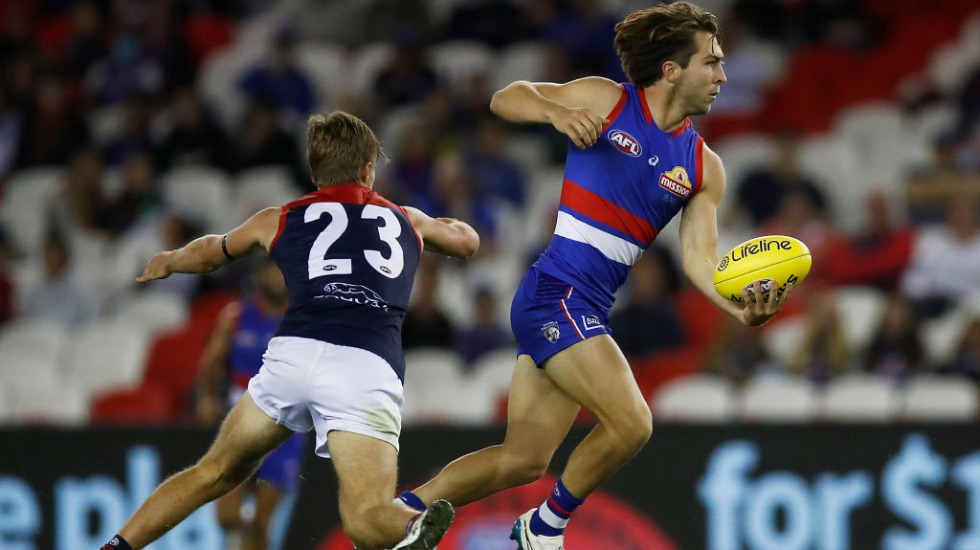Bulldog Rhylee West ducks inside Melbourne opponent James Jordon to launch an attack on Monday. Photo: GETTY IMAGES
It was that renowned philosopher Leigh Matthews who purloined for the purposes of AFL football the popular saying: “Things are never as good or bad as they seem”.
It’s proven apt too many times in football history to recite here, but I suspect seldom more so than with regards the AFL’s new “man on the mark” rule.
Not for the first time, there was a massive overreaction to the first instances of the rule being trialled in actual football games, several months after, predictably, it had been announced to barely a squeak.
And, not for the first time, there may also have been an over-correction to that initial panic by some hailing the rule tweak as a potential saviour of the game after only a handful of pre-season matches. The truth, not unusually, probably lies somewhere in between.
A few seconds of footage from an Essendon intra-club hit-out a couple of weeks ago, when Kyle Langford was penalised 50 metres for not doing much at all whilst standing the mark, then a penalty close to goal in a West Coast-Fremantle scratch match, had sparked the initial outrage.
Similarly, a free-flowing and relatively high-scoring opening AAMI Series game between St Kilda and Carlton last Thursday seemed enough for some to declare the latest rule change a massive win for the game’s aesthetics. Both reactions are ridiculously premature.
Having said that, however, the prevention of the man on the mark creeping sideways to cut off the player with the ball’s options does seem to have at least opened things up by degrees, and certainly not heralded a flood of 50-metre penalties for inconsequential infringements.
In seven games over the AAMI Series prior to the time of writing, we’d witnessed a mere handful of 50s dished out for transgressions to the new rule. It doesn’t seem to have taken players long to adjust at all.
And the benefits were always going to be more obvious when the man on the mark was told to “stand” closer to the wing than the central corridor. As were the tactics teams would adopt both offensively and defensively to counter or exploit the change.
We saw St Kilda players against the Blues dropping back five metres from the set mark before umpires had called “stand” to enable them to move laterally. On Saturday night, Geelong several times against Essendon had a teammate run parallel to the player with the ball to receive a handpass, the extra width opening up options further afield even more as the opponent on the mark stood rooted to the spot.
Even the naked eye would have told you over the weekend more players were looking for the “inside” kick to open up play. That’s an immediate tick. And so might be a seeming flow-on effect of that desire, that is, more turnovers, the points scored from which were up over the first seven practice games (from an admittedly tiny sample size).
PLEASE HELP US CONTINUE TO THRIVE BY BECOMING AN OFFICIAL FOOTYOLOGY PATRON. JUST CLICK THIS LINK.
If that trend were to hold, you could add increased scoring and greater unpredictability as consequences of the change. And surely, most people would consider those two more ticks on the positive side of the ledger.
If those positives continue (and it’s still a big “if”), the temptation will be to sheet all the credit to the man on the mark change.
But AFL football operations manager Steve Hocking has spoken a lot in recent years about the “pulling of levers” in the on-going attempt to free the game from overly-defensive shackles, and the man on the mark rule may be just one in conjunction with other less-debated changes for 2021, such as the dragging back of the man on the mark an extra five metres at kick-ins, and the further reduction of the interchange cap from 90 rotations to 75.
Collingwood coach Nathan Buckley alluded to that combined impact after his team’s hit-out against Richmond on Friday night.
Count me in the camp who thought the reduction from 90 to 75 would have little discernible impact. After all, a far greater reduction from a 120-interchange limit to 90 several years ago had zero impact on the look of the game.
Perhaps, though, while it may have taken us too many years to hit the magic number, this latest decrease has finally got to the tipping point at which players’ reduced bench time actually does cause enough fatigue to prove a factor.
That, combined, of course, with more “up-and-back” running due to more turnovers coming from those greater numbers of “inside” kicks. Plus, as Buckley pointed out, players who haven’t played traditional length games of football now for just on 18 months.
But, yes, whilst that observation seems a positive for the argument about a more open, flowing brand of football in 2021, so could it also be read as something of a warning about going the “early crow” on any impact of the new rules.
Players have shown in just one weekend without too many draconian penalties dished out for continuing to move on the mark that they can be pretty quick to adjust to change.
So it figures that it won’t take too many rounds of the “real thing” this season for their match fitness levels to adjust back to the sorts of game times we saw before the pandemic reduced match duration for the 2020 season by roughly 20-odd minutes.
That will curb the impact of fatigue. While those fixated on scoring rather than merely the openness of play (the latter of which is in my view a far more important objective) should take note that the early rounds of a season, played on firmer grounds by players less match fit and whose defensive structures are still being refined, have long tended to produce higher scores.
What does it all mean? Only that we really won’t know just how great an impact the changes have made for some time yet.
The best advice may well be just to adopt Leigh Matthews’ philosophy and be extremely wary of any grand or definitive pronouncements made about new rules, or indeed anything in AFL football. Particularly those made in March.
This article first appeared at ESPN.











